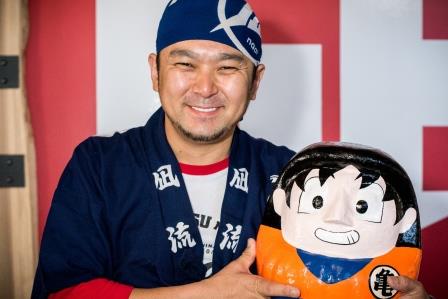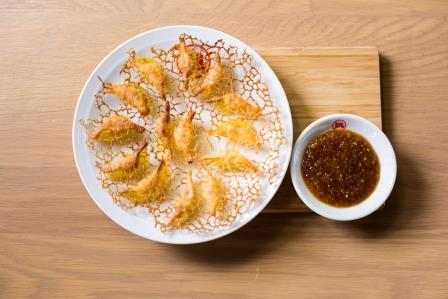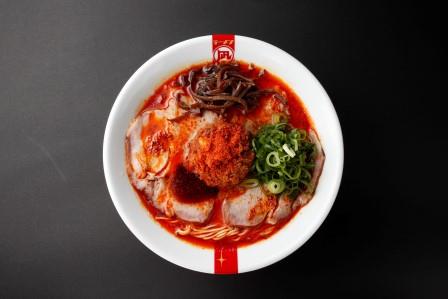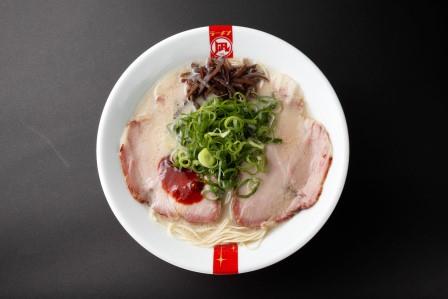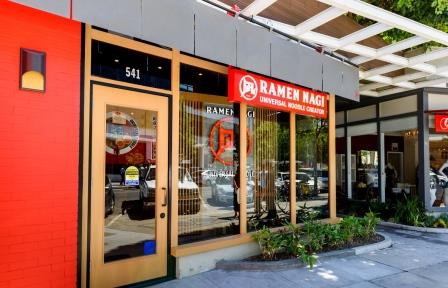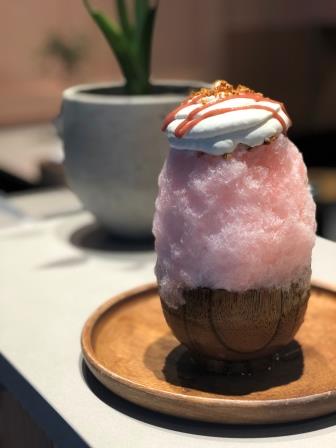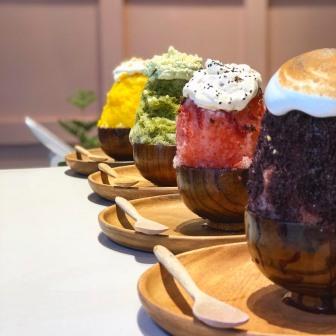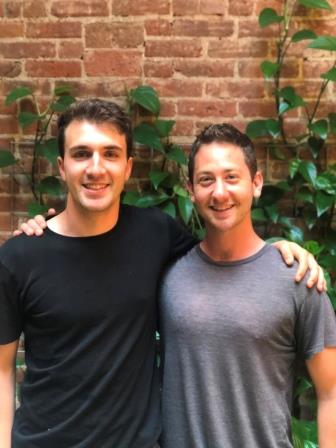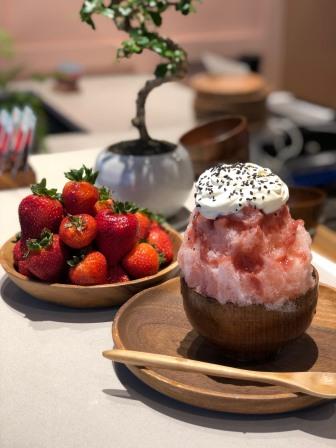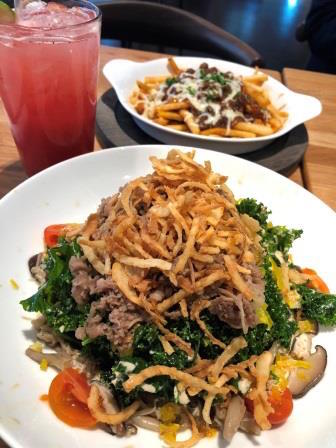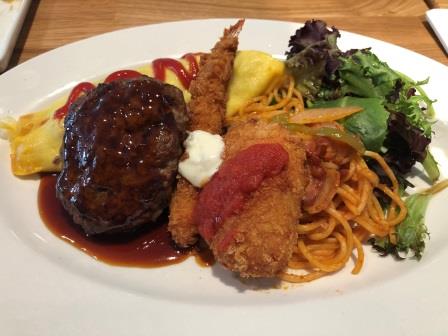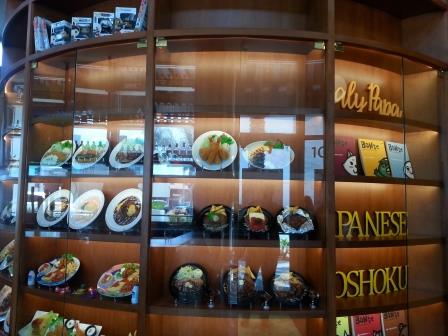Ramen Nagi Steady advance in “ramen restaurant operation”, which started out with mere 7 seating space, and being open only one day a week
By Elli Sekine
At last, “Nagi”, a ramen restaurant chain, which is growing very quickly in Japan and Asia, opened the first US location in Palo Alto in June. Since their name is very well-known in Japan, people started to wait in the line for over an hour immediately after its opening, filling up the street. Currently, there are 11 “Nagi”s in Japan alone, and 28 more in the rest of Asia. Nagi can be recognized as the management philosophy of the new era, which is an innovative management technique that “brings out the maximum profit from the minimum investment”.
Nagi has been raised to a very successful restaurant chain.
The founder, Tomoshi Ikuta, and his partner Sonoda, are both from the Fukuoka Prefecture.
They worked together in a wellknown ramen chain in Kokura when they were still in High school. Their success was not produced by a wellthought-out planning. Their actions taken out of necessity between chances and survivals happened to meet the needs of the time, and found its path to grow. Their ramen business was first started from the very bottom, and was running with mere 7-seating space, which was rented in a narrow bar in Shinjuku’s Golden Street, and they were only open once a week. Since there was no kitchen in the bar, the preparation was done in Mr. Ikuta’s small apartment. Despite all that, Ikuta’s keen sense in making ramen was already standing out. So, what is so innovative about their management style? First of all, it is their cutting-edge menu creation. They started out with tonkotsu base, but the final ingredient they settled on after going to ramen restaurants across the nation, trying, in search of the kind of ingredient they could bring to the narrow kitchen space, was “Niboshi” (small dried fish).
“Niboshi ramen”, which was not familiarized in Tokyo area at that time, was featured big in a magazine, and on top of it, the winning for the ramen contest ignited fire at the Shinjuku Golden Street location. The second of all, it is their magical skill to make themselves known through no advertisement. By participating in various festivals and events, they stands out with good taste, which creates a topic of conversation in the audience.
The third is how they manage the restaurant. In the Shibuya location, they ran it as a ramen restaurant in the day time, and as a ramen izakaya at night, and they even call themselves differently. It is so unique. Without realizing, their business advanced in high-speed. They eventually got an offer even from an overseas investor. The fourth reason is how quickly they developed overseas market. The first one was realized within 6 years, and since then, they managed to acquire a total of 28 overseas locations in Hong Kong, Shanghai, Philippines, and Singapore within 10 years. And, then, this year, they achieved to open the first development in US with their partner, a Taiwanese company. The fifth reason is their revolutionary way of working. Unlike the typical image of the industry, which is rather tough, they are creating the kind of easy working environment for their staff, in which “Enjoy while you work” is encouraged.
The Palo Alto location has a spacious interior with 52 seats. All overseas locations have only tonkotsu-base soup. All except their signature ramen called “Original King” (tonkotsu-base, $13.50) is $14.50. Three other most innovative menu items are “Black King” flavored with squid ink and black garlic as an effective accent, “Red King” flavored with red pepper miso, and “Green King” flavored with refreshing basil with parmesan cheese to accentuate. Each colorful menu item is unique, and can accommodate diversified diet styles. All noodles are made in-house by their noodle making artisans using the famous machine in Japan called “Yamato Noodle Machine”, which was acquired from Japan, and installed there to make various noodles to match each different flavored soup. In addition to those menu items, they provide a “wagamama sheet”, with which you can choose by check-marking the strength of soup, amount of oil, garlic, toppings, and even the hardness of the noodles to suit to your taste. As far as the menu goes, those combinations are something I never even thought of until I saw them.
For instance, squid ink, and basil flavor, each of which has a good balance in taste, are surprisingly delectable. Ramen nowadays is evolving toward many different directions including Italian and Mediterranean.
The ramen boom in the US has been lasting for the last 10 years, and the industry was thinking that it would reach the peak soon. However, the landing of this innovative ramen chain is making me think that there is more room to go further. Following the Palo Alto location, opening of the second location in LA, and also in NY is already in the works. The “Nagi” sensation is about to begin here in the US as well with their new managing technique and unique menu creation.
週一営業、7席から始まった「ラーメン店経営」快進撃
日本とアジアで急成長中のラーメンチェーン店、「Nagi」がついにこの7 月、米国進出第一号店をパラアルトにオープンした。日本の有名店とあって開店まもなく1時間以上の列が歩道を埋め尽くした。現在「凪」は、日本に11 店舗だが、アジア圏には28 店舗を展開している。Nagiは、新時代の経営哲学と言える、「必要最低限の出資から最大利益を生み出す」革新的な経営法だ。トレンドを追う消費者とSNS情報が繁栄店に押し上げた。
創業者である生田智志氏とパートナーの園田氏は同じ福岡県出身。高校時代小倉の有名ラーメンチェーン店で働いていた同期である。彼らの成功は、綿密な計画から生まれたものではない。チャンスとサバイブの間で必然的にとった行動が時代に適合し成長路線を見出していった。裸一貫から始まったラーメン業は、新宿ゴールデン街の狭い7席のバーを借りての経営だった。それも週一回のみ。キッチンが無いので、生田氏の狭いアパートの一室で仕込みをしていたという。しかしその頃から同氏のラーメンセンスは長けていた。
なにが革新的なのか? その1は斬新なメニュー作り。基本は豚骨ベースから始まったが、彼らは狭いキッチンに持ち込める範囲の食材を探し全国のラーメン店を試食して歩いた結果出会ったのが「煮干し」だった。東京ではまだ聞きなれない「煮干しラーメン」が雑誌にクローズアップされたり、コンテストでの優勝もあり、新宿ゴールデン街店に火がついた。革新その2は宣伝をせず有名になる術。フェスやイベントに出店し、とにかく目立つ、美味しいで常に話題を作る。
革新その3は店作り。初独立店舗となった渋谷店では、昼間はラーメン屋、夜はラーメン居酒屋とし昼と夜で屋号も変わるユニークさ。それからの快進撃はあっという間。ついに海外投資家からも声がかかる。革新その4は海外進出の速さだ。第1号は6 年以内、他香港、上海、フィリピン、シンガポールの海外28 店舗を10年以内で遂げている。そして今年、台湾企業のパートナーと米国進出を果たした。革新その5は、働き方改革である。今までにありがちの筋肉質なイメージから「楽しみながら働こう」という無理のない職場環境作りを打ち出している。
パラアルト店は全52 席の広々とした内装。海外店舗は豚骨ベースのみ。代表格の「Original King」( 豚骨ベース$13.50)以外は全て$14.50。4つの斬新メニューは、ブラックガーリックが効いたイカスミ味の「Black King」と赤辛味噌の「Red King」、そしてバジル味が爽やかでパルメザンチーズでアクセントを付けた「Green King」。色とりどりのメニューはそれぞれに特徴があり、多様化するダイエットにもフィットする。麺は全て自家製麺。日本で有名な「大和製麺機」を導入し、職人たちがスープにあった麺を作り出す。メニューに加え“ わがまま表” には、スープの濃さ、オイルの量、ガーリックやトッピング麺の硬さまでチェック項目があり、自分好みの一杯が注文できる。このメニューを見る限り、今まで想像がつかなかった組み合わせなのだが、例えばイカスミやバジルもそれぞれに味のバランスが取れてて驚くほど「アリ」である。ラーメンは今やイタリアン風にも地中海風にも進化している。
米国のラーメンブームはこの10 年続いており、業界ではそろそろ頭打ちと想像していたが、この革新的なラーメンチェーン店の上陸で、まだまだ伸び代がある事を思い知らされる。パラアルト店に続きすでに2号店, LA, NY のオープンも決まっている。米国でもすでに新しい経営術とユニークなメニューで「凪」旋風が巻き起ころうとしている。
Ramen Nagi
541 Bryant St.
Palo Alto, CA 94301
http://ramennagiusa.com/
Open everyday
11:00am-3:00pm
5:30pm-9:30pm
At last, “Nagi”, a ramen restaurant chain, which is growing very quickly in Japan and Asia, opened the first US location in Palo Alto in June. Since their name is very well-known in Japan, people started to wait in the line for over an hour immediately after its opening, filling up the street. Currently, there are 11 “Nagi”s in Japan alone, and 28 more in the rest of Asia. Nagi can be recognized as the management philosophy of the new era, which is an innovative management technique that “brings out the maximum profit from the minimum investment”.
Nagi has been raised to a very successful restaurant chain.
The founder, Tomoshi Ikuta, and his partner Sonoda, are both from the Fukuoka Prefecture.
They worked together in a wellknown ramen chain in Kokura when they were still in High school. Their success was not produced by a wellthought-out planning. Their actions taken out of necessity between chances and survivals happened to meet the needs of the time, and found its path to grow. Their ramen business was first started from the very bottom, and was running with mere 7-seating space, which was rented in a narrow bar in Shinjuku’s Golden Street, and they were only open once a week. Since there was no kitchen in the bar, the preparation was done in Mr. Ikuta’s small apartment. Despite all that, Ikuta’s keen sense in making ramen was already standing out. So, what is so innovative about their management style? First of all, it is their cutting-edge menu creation. They started out with tonkotsu base, but the final ingredient they settled on after going to ramen restaurants across the nation, trying, in search of the kind of ingredient they could bring to the narrow kitchen space, was “Niboshi” (small dried fish).
“Niboshi ramen”, which was not familiarized in Tokyo area at that time, was featured big in a magazine, and on top of it, the winning for the ramen contest ignited fire at the Shinjuku Golden Street location. The second of all, it is their magical skill to make themselves known through no advertisement. By participating in various festivals and events, they stands out with good taste, which creates a topic of conversation in the audience.
The third is how they manage the restaurant. In the Shibuya location, they ran it as a ramen restaurant in the day time, and as a ramen izakaya at night, and they even call themselves differently. It is so unique. Without realizing, their business advanced in high-speed. They eventually got an offer even from an overseas investor. The fourth reason is how quickly they developed overseas market. The first one was realized within 6 years, and since then, they managed to acquire a total of 28 overseas locations in Hong Kong, Shanghai, Philippines, and Singapore within 10 years. And, then, this year, they achieved to open the first development in US with their partner, a Taiwanese company. The fifth reason is their revolutionary way of working. Unlike the typical image of the industry, which is rather tough, they are creating the kind of easy working environment for their staff, in which “Enjoy while you work” is encouraged.
The Palo Alto location has a spacious interior with 52 seats. All overseas locations have only tonkotsu-base soup. All except their signature ramen called “Original King” (tonkotsu-base, $13.50) is $14.50. Three other most innovative menu items are “Black King” flavored with squid ink and black garlic as an effective accent, “Red King” flavored with red pepper miso, and “Green King” flavored with refreshing basil with parmesan cheese to accentuate. Each colorful menu item is unique, and can accommodate diversified diet styles. All noodles are made in-house by their noodle making artisans using the famous machine in Japan called “Yamato Noodle Machine”, which was acquired from Japan, and installed there to make various noodles to match each different flavored soup. In addition to those menu items, they provide a “wagamama sheet”, with which you can choose by check-marking the strength of soup, amount of oil, garlic, toppings, and even the hardness of the noodles to suit to your taste. As far as the menu goes, those combinations are something I never even thought of until I saw them.
For instance, squid ink, and basil flavor, each of which has a good balance in taste, are surprisingly delectable. Ramen nowadays is evolving toward many different directions including Italian and Mediterranean.
The ramen boom in the US has been lasting for the last 10 years, and the industry was thinking that it would reach the peak soon. However, the landing of this innovative ramen chain is making me think that there is more room to go further. Following the Palo Alto location, opening of the second location in LA, and also in NY is already in the works. The “Nagi” sensation is about to begin here in the US as well with their new managing technique and unique menu creation.
週一営業、7席から始まった「ラーメン店経営」快進撃
日本とアジアで急成長中のラーメンチェーン店、「Nagi」がついにこの7 月、米国進出第一号店をパラアルトにオープンした。日本の有名店とあって開店まもなく1時間以上の列が歩道を埋め尽くした。現在「凪」は、日本に11 店舗だが、アジア圏には28 店舗を展開している。Nagiは、新時代の経営哲学と言える、「必要最低限の出資から最大利益を生み出す」革新的な経営法だ。トレンドを追う消費者とSNS情報が繁栄店に押し上げた。
創業者である生田智志氏とパートナーの園田氏は同じ福岡県出身。高校時代小倉の有名ラーメンチェーン店で働いていた同期である。彼らの成功は、綿密な計画から生まれたものではない。チャンスとサバイブの間で必然的にとった行動が時代に適合し成長路線を見出していった。裸一貫から始まったラーメン業は、新宿ゴールデン街の狭い7席のバーを借りての経営だった。それも週一回のみ。キッチンが無いので、生田氏の狭いアパートの一室で仕込みをしていたという。しかしその頃から同氏のラーメンセンスは長けていた。
なにが革新的なのか? その1は斬新なメニュー作り。基本は豚骨ベースから始まったが、彼らは狭いキッチンに持ち込める範囲の食材を探し全国のラーメン店を試食して歩いた結果出会ったのが「煮干し」だった。東京ではまだ聞きなれない「煮干しラーメン」が雑誌にクローズアップされたり、コンテストでの優勝もあり、新宿ゴールデン街店に火がついた。革新その2は宣伝をせず有名になる術。フェスやイベントに出店し、とにかく目立つ、美味しいで常に話題を作る。
革新その3は店作り。初独立店舗となった渋谷店では、昼間はラーメン屋、夜はラーメン居酒屋とし昼と夜で屋号も変わるユニークさ。それからの快進撃はあっという間。ついに海外投資家からも声がかかる。革新その4は海外進出の速さだ。第1号は6 年以内、他香港、上海、フィリピン、シンガポールの海外28 店舗を10年以内で遂げている。そして今年、台湾企業のパートナーと米国進出を果たした。革新その5は、働き方改革である。今までにありがちの筋肉質なイメージから「楽しみながら働こう」という無理のない職場環境作りを打ち出している。
パラアルト店は全52 席の広々とした内装。海外店舗は豚骨ベースのみ。代表格の「Original King」( 豚骨ベース$13.50)以外は全て$14.50。4つの斬新メニューは、ブラックガーリックが効いたイカスミ味の「Black King」と赤辛味噌の「Red King」、そしてバジル味が爽やかでパルメザンチーズでアクセントを付けた「Green King」。色とりどりのメニューはそれぞれに特徴があり、多様化するダイエットにもフィットする。麺は全て自家製麺。日本で有名な「大和製麺機」を導入し、職人たちがスープにあった麺を作り出す。メニューに加え“ わがまま表” には、スープの濃さ、オイルの量、ガーリックやトッピング麺の硬さまでチェック項目があり、自分好みの一杯が注文できる。このメニューを見る限り、今まで想像がつかなかった組み合わせなのだが、例えばイカスミやバジルもそれぞれに味のバランスが取れてて驚くほど「アリ」である。ラーメンは今やイタリアン風にも地中海風にも進化している。
米国のラーメンブームはこの10 年続いており、業界ではそろそろ頭打ちと想像していたが、この革新的なラーメンチェーン店の上陸で、まだまだ伸び代がある事を思い知らされる。パラアルト店に続きすでに2号店, LA, NY のオープンも決まっている。米国でもすでに新しい経営術とユニークなメニューで「凪」旋風が巻き起ころうとしている。
Ramen Nagi
541 Bryant St.
Palo Alto, CA 94301
http://ramennagiusa.com/
Open everyday
11:00am-3:00pm
5:30pm-9:30pm





